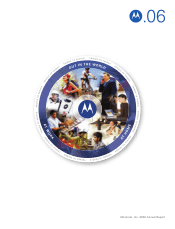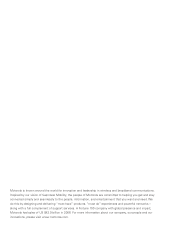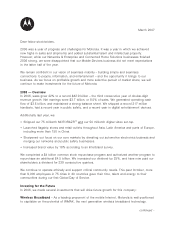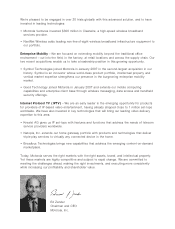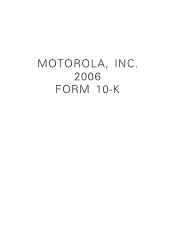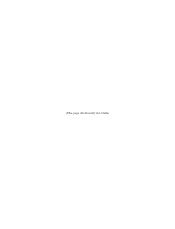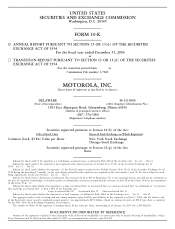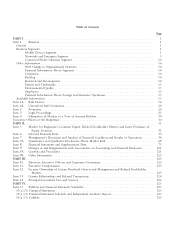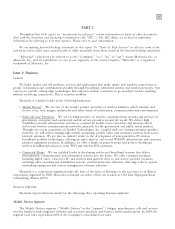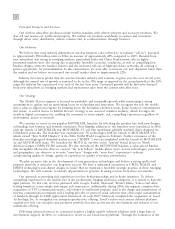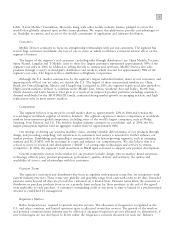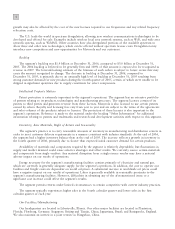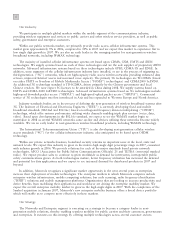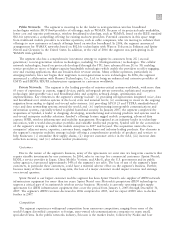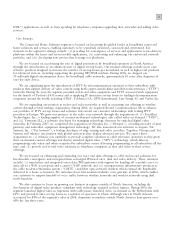Motorola 2006 Annual Report Download - page 11
Download and view the complete annual report
Please find page 11 of the 2006 Motorola annual report below. You can navigate through the pages in the report by either clicking on the pages listed below, or by using the keyword search tool below to find specific information within the annual report.
3
LiMo (Linux Mobile) Foundation, Motorola along with other mobile industry leaders, pledged to create the
world's first globally adopted open mobile Linux platform. We expect this platform to provide cost advantages to
us, flexibility to carriers, and access to the world's community of application and software developers.
Customers
Mobile Devices continues to focus on strengthening relationships with our top customers. The segment has
several large customers worldwide, the loss of one or more of which could have a material adverse effect on the
segment's business.
The largest of the segment's end customers (including sales through distributors) are China Mobile, Verizon,
Sprint Nextel, Cingular and T-Mobile. Sales to these five largest customers represented approximately 39% of the
segment's net sales in 2006. In addition to selling directly to carriers and operators, Mobile Devices also sells
products through a variety of third-party distributors and retailers, which account for approximately 38% of the
segment's net sales. The largest of these distributors is Brightstar Corporation.
Although the U.S. market continued to be the segment's largest individual market, many of our customers, and
approximately 65% of our net sales, are outside the U.S. The largest of these international markets are China,
Brazil, the United Kingdom, Mexico and Hong Kong. Compared to 2005, the segment experienced sales growth in:
High Growth markets (defined as countries in the Middle East, Africa, Southeast Asia and India), North Asia,
North America and Latin America. Sales grew as a result of an improved product portfolio, including continued
demand worldwide for the MOTORAZR family, continued strong market growth in emerging markets, and high
replacement sales in more mature markets.
Competition
The segment believes it increased its overall market share to approximately 22% in 2006 and remains the
second-largest worldwide supplier of wireless handsets. The segment experiences intense competition in worldwide
markets from numerous global competitors, including some of the world's largest companies, such as Nokia,
Samsung, Sony Ericsson and LG. The wireless handset industry continues to consolidate and, in 2006, the five
largest participants together held an aggregate market share of approximately 86%.
Our strategy of driving our seamless mobility vision, creating valuable differentiation of our products through
design, and providing compelling, rich experiences to consumers and carriers is intended to further enhance our
market position. Establishing and expanding a strong position in the fastest-growing segments, such as emerging
markets and 3G/UMTS, will be necessary to retain and enhance our competitiveness. We also believe that it is
critical to invest in research and development (""R&D'') of cutting-edge technologies and services to remain
competitive. In 2006, the segment's total investment in R&D again increased to support new product development.
General competitive factors in the market for our products include: design; time-to-market; brand awareness;
technology offered; price; product proposition, performance, quality, delivery and warranty; the quality and
availability of service; and relationships with key customers.
Payment Terms
The segment's customers and distributors buy from us regularly with payment terms that are competitive with
current industry practices. These terms vary globally and generally range from cash-with-order to 60 days. Extended
payment terms beyond 60 days are provided to customers on a limited basis. Payment terms allow the customer or
distributor to purchase products from us on a periodic basis and pay for those products at the end of the agreed
term applicable to each purchase. A customer's outstanding credit at any point in time is limited to a predetermined
amount as established by management.
Regulatory Matters
Radio frequencies are required to provide wireless services. The allocation of frequencies is regulated in the
U.S. and other countries, and limited spectrum space is allocated to wireless services. The growth of the wireless
and personal communications industry may be affected if adequate frequencies are not allocated or, alternatively, if
new technologies are not developed to better utilize the frequencies currently allocated for such use. Industry

